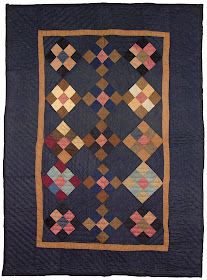 |
| "A Star in the Garden" 2010 by Mary Kerr |
Mary Kerr is one of my Facebook friends, but we hadn't met in person before Wednesday. My class was on lunch break and a few of us were enjoying delicious barbecue pulled pork sandwiches while sitting on a park bench outside the museum. New friends and classmates Carol Beck and Judy Lyons were there. At one point, I turned to the left and there was Mary walking toward us. I recognized her from her Facebook photos, but since my mug shot doesn't appear on Facebook, I needed to introduce myself.
 We hit it off immediately, and wanted more time to visit, but classes were soon starting up again. Later on, we agreed to get together after classes on Thursday for a visit before the benefit auction at the museum. Luckily, she was teaching right across the hall. At the end of the day, we headed toward the downtown area, but not before I purchased a copy of her recent book "Vintage Revisited: A Quilt Block Challenge". On our way over to Whaler's Catch, we stopped at a local antique shop. A classmate had told me there was a New York Beauty quilt top for sale. Luckily, it was still there. After a quick haggle with the nice gentleman at the register, I pretty much bought it on the spot.
We hit it off immediately, and wanted more time to visit, but classes were soon starting up again. Later on, we agreed to get together after classes on Thursday for a visit before the benefit auction at the museum. Luckily, she was teaching right across the hall. At the end of the day, we headed toward the downtown area, but not before I purchased a copy of her recent book "Vintage Revisited: A Quilt Block Challenge". On our way over to Whaler's Catch, we stopped at a local antique shop. A classmate had told me there was a New York Beauty quilt top for sale. Luckily, it was still there. After a quick haggle with the nice gentleman at the register, I pretty much bought it on the spot.We bumped into several of Mary's friends along the way. Some of them already knew who I was. As one of the only guys around, and being 6'4" tall, it's probably foolish to think I'd ever blend in or go unnoticed among a gathering of quilters. Plus, a lot more people read my blog that I'd realized. That felt good. At Whaler's Catch we ran into more quilt people, including Merrily McKim Tuohy- Ruby McKim's granddaughter! Wow!!! Sharon Pinka was there, too. She and I had e-mailed a while back about her research on the Rainbow Quilt Block Company.
After a delightful conversation, I accompanied Mary back to the museum for the auction. I hadn't planned to bid and didn't even know what was being auctioned, but she registered. We made our way to the back of a packed room and found a place to sit. What a newb I am - I didn't know they were auctioning the amazing quilts from the Pilgrim/Roy Challenge, which I'd seen hanging in the hallway outside the classroom for the last three days. One of those quilts - "A Star in the Garden" - was made by Mary. I'd been admiring it all week. The quilt is a whimsical blend of old and new. Visually dazzling, it includes vintage red diamonds on white, set in curvy paths, with a bold, bright floral print background - the fabric from the Pilgrim/Roy Challenge - and a slightly off-center vintage star block medallion.
As the items were being auctioned, I opened Mary's book and read the forward written by another gem of the quilt world, Pepper Cory, who beautifully summarized the importance and the beauty of the whole "Vintage Revisited" project, saying she wished she'd thought of it. Coming from Pepper, that's high praise. Just as I was reading, Mary's Pilgrim/Roy Challenge Quilt came up for auction. She seemed a little worried about it not netting enough proceeds to be worthwhile for the fundraiser, but I wasn't worried about that. So I asked if I could borrow her bidding card, bid on her quilt, and was the lucky winner!
At first, she thought I was bidding for her and said, "Well, I guess I just bought back my quilt." However, I didn't plan on leaving Paducah without that quilt in my bag. It may have seemed like a totally impulsive purchase on my part, but in my mind, it was really more like quick thinking after a sudden, significant realization. Of course I wanted the quilt! It's an ideal example of what Mary had done so brilliantly in her book, and it's importance is very evident. She and the other artists in her book had combined old blocks with new materials to make totally unique works of art. Among the Pilgrim/Roy Challenge quilts, her quilt stood out for this reason.
I couldn't wipe the smile off my face on the drive back to the hotel, and couldn't get that old E.L.P. song out of my brain. If I hadn't been lucky enough to hang out with Mary after class, I probably would've missed the auction and never would've realized what I was missing until it was too late. Dumb luck on my part, but luck nonetheless.
"Ooooh, what a lucky man he was."










































